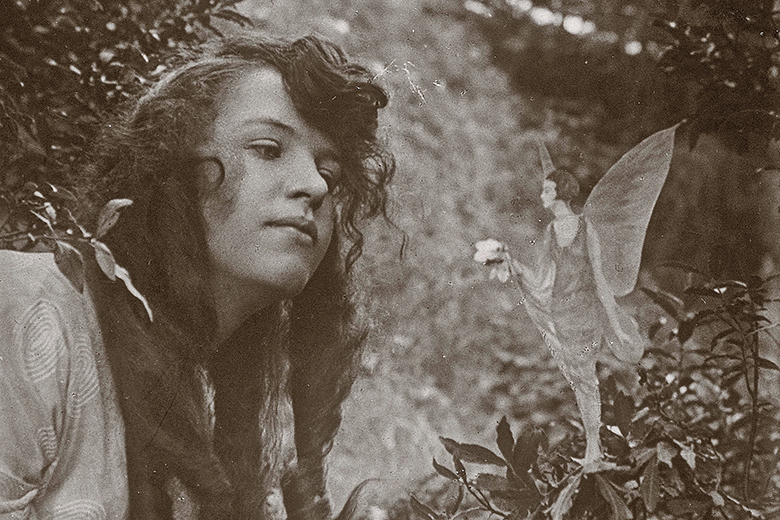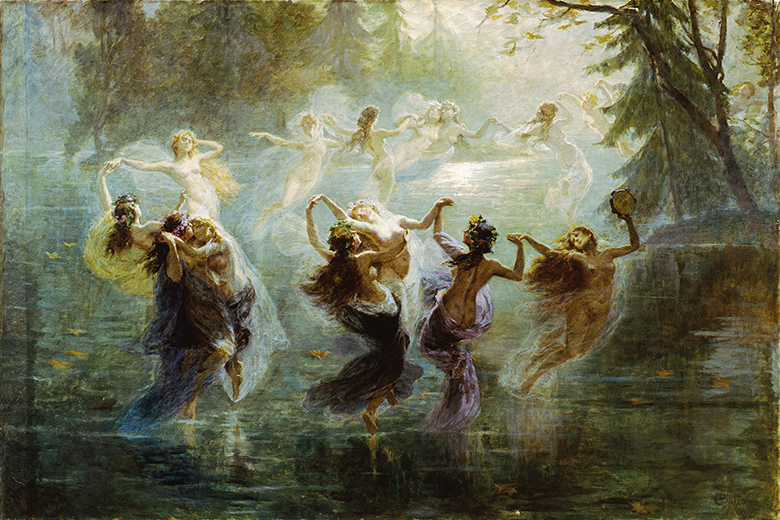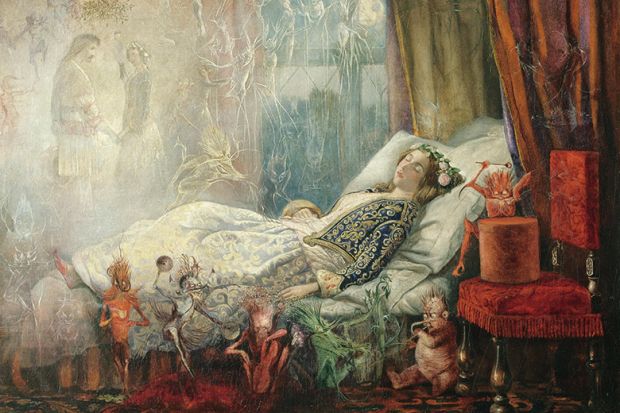I first came to fairies after a brush with mortality in my mid-thirties. I’d been trained as a medievalist, but under the strain of my treatment, the Monumenta Germaniae Historica lost their charms: the memory of their leather covers, their weight in my hand, their smell, still make me nauseous almost a decade later.
I’d like to say that the fairies flew in through the window, but they actually came out of the pages of books read in convalescence. The obsession grew slowly. It started with pencil scratches in margins. It turned into a blog. Then it became articles: I mapped boggart place names while my children were falling asleep; I transcribed forgotten fragments of 19th-century fairylore as students took exams. By 2013, it had got serious and expensive. I was dumpster-diving, trying to rescue the lost manuscript of a recently deceased fairy expert (I succeeded eventually). A year later, I was setting up an online survey of supernatural attitudes and experiences, the Fairy Census. Last summer, I had an Oxford graduate surreptitiously photograph a couple of thousand pages of Edwardian fairy archives in the Bodleian Library. More recently, our postwoman delivered to me a volume that I co-edited with Ceri Houlbrook, an early career researcher at the University of Hertfordshire, on British and Irish fairies. Reading the chapters again does not, as I had hoped, dim the obsession. It only makes it burn a little brighter, underlining all the new mysteries to plumb, the new sources to chase.
Obsessions are supposed to bring at least some benefits. Trainspotting gets its adherents out of the house on Sundays; Dungeons and Dragons teaches rudimentary social skills; Tetris hones spatial intelligence. But what are the benefits of an obsession with fairies? Well, by far the most important is that you come into contact with many curious and, frequently, wonderful people. In recent years, I’ve had messages from scores of men and women who have fairy issues in their lives: one requested advice on the right hill on which to enjoy a midnight shamanic fairy meeting; another told of a kitchen haunted by goblins. And I’m often asked whether I can see a fairy in this particular CCTV footage or in that photograph. My replies to such correspondents tend to be polite but necessarily brief.
I also, however, find myself in contact with those who are, in much the same way as I am, fascinated by the idea of an invisible commonwealth coterminous with our own world. This is the most enjoyable consequence of writing and speaking about fairies, for there are a surprisingly large number of fairy lovers (and professional fairy sceptics) out there. All too predictably, they are often artists, folklorists, mystics or writers. But there are also servicemen, scientists and engineers, members of thinktanks and even Gulf millionaires.
Most keep their interest very quiet because fairyism is a love that dare not speak its name. There is a distaste towards fairies among the chattering classes, and that distaste is particularly strong among academics. Study witches, ghosts or vampires, and you will pass through any Oxbridge dinner successfully. However, fairies are about as welcome as Heineken at high table. I teach Italian history in Siena and have long experienced a milder version of this. My colleagues treat my interest in fairylore and the supernatural as a forgivable but not a lovable eccentricity. For someone interested in the subject, this stance is frustrating because fairies have so much to offer the researcher and teacher. They demand a multidisciplinary approach, combining the likes of anthropology, art history, comparative mythology, folklore, history, literature, theatre, philology and onomastics (the study of proper names). Fairies can be found (with different labels) in most places and periods, inviting comparative work. And while they may vex professors, they are objects of fascination in the lecture hall: say the word “fairy” and students look up from their iPhones.
One result of campus fairyphobia is that many of our most talented fairy writers have nothing to do with universities. Indeed, perhaps half of the best books that we have on fairylore in English were written by authors outside the academy or, in a couple of cases, academics in the process of extricating themselves from it. While editing our book, Ceri and I coordinated a team of academic and non-academic writers. Rereading the book in its published form, I would say that the three most important chapters, in a crowded and competitive field, were written by people without “Dr” in front of their name.
A consequence of being an expert in something that most people are embarrassed to discuss is having to handle frequent media enquiries. Emails begin not with “As an acknowledged expert…” but rather, “You were the only name we could find…” I have to admit that I generally savour these encounters. Journalists are, in my experience, courteous, intelligent and witty. But, as any academic who has ever had encounters with the press will know, you can find yourself in some bizarre situations. Technicians for Radio New Zealand asked me to do a long-distance interview sitting under my desk with a sheet over my head because it was the only way to get the acoustics right. A Japanese TV crew threatened to fly to my home in Tuscany to do a three-minute segment in my living room (sanity ultimately prevailed and they instead ran off to the English Midlands to look for gnomes: fairy shame does not, generally speaking, extend to East Asia).
I even sometimes contact the media for my own ends. This can go wonderfully well. Last year, I gathered Nottingham fairylore with a coordinated push in the local newspapers and on local radio and television – several “don’t-tell-anyone-but” emails resulted. Sometimes, however, things do not quite turn out as expected. While publicising my book, what I thought was an innocent press release on modern fairy sightings led to headlines about fairy sex. So much for taking enchantment seriously! Human voices wake us and we drown.

There is an obvious reason why fairies are anathema to so many people – the misleadingly cutesy image of them that we carry around in our heads. As it happens, this kind of fairy is only part of the story. Yes, there are the tiny, smiling, tutu-wearing fairies of Disney, whose sweat is saccharine and who burp pixie dust. But there are also the blood-hungry, baby-stealing, bed-hopping fairies of tradition. The Disney fairy has a fascinating genealogy. She (and it is almost always a she) began life in British art in the late 1700s (although it can be argued that a prototype was floating around in the Elizabethan and Jacobean poets). She grew stronger in children’s storybooks in the 1800s. Then she took flight in occult works in the late 1800s and early 1900s, in what became in essence the philosophical wing of spiritualism, theosophy. The Cottingley photographs (above), which appear to show groups of fairies with young girls and which proved to be the apotheosis of the modern fairy, were sponsored by theosophists and brought to public attention by Sir Arthur Conan Doyle. And it is remarkable how modern fairy films are, unknowingly, vehicles for theosophical ideas about nature and the soul. Anyone who watches these films will know that Tinker Bell and her sugarplum cohorts won the war against the traditional fairy. Like the battle between grey and red squirrels in British woods, the older species was wiped out by degrees: in the UK, traditional fairies survived in very few places past the Great War, and even in Ireland, traditional fairies rarely made it through the Second World War.
The less obvious but perhaps fundamentally more important reason why fairies are avoided by decent society relates to conventions of belief. In our society, you can glimpse a ghost or believe that certain people have magical powers and keep your friends; this is not necessarily the case with fairies. Try it for yourself. Turn up at a Christmas party and announce that you’ve seen a phantom in the car park and you’ll get an interested if jokey audience; claim that you’ve spied a fairy or, for that matter, an angel with a flaming sword and people will begin to back away. Quite why it should be socially acceptable to believe in the spirit of your dead grandmother but not fairies is unclear to me. However, in my fairy survey, which collected together 500 modern fairy experiences from around the English-speaking world, the single most common sentiment is the fear that the respondent will look foolish if their experience is publicly associated with them.
For my part, I have never seen a ghost or a fairy, and I am quite clear in my own mind that my handful of “supernatural” experiences were interesting hallucinations. But I find this division very limiting. One thing that comes out of studying different paranormal encounters is their unity. Yes, there is a great Archipelago of the Impossible, which, as well as the Island of Fairy, also includes the Island of the Undead, the Island of Demons, the Island of Hairy Hominids and the Island of Little Green Men Who Visit Your Bedroom. But, in the end, all these isles are clearly just the peaks of a single submerged continent (which the Neoplatonist Plotinus long ago mapped). Indeed, one of the most fascinating points to come out of my fairy research is the struggle that people have in deciding which island they should locate their experience upon.

A question that I always ask fairy believers – although it could equally be put to believers in, say, ghosts or aliens – is how it is that their fairies are so different from those our great-great-grandparents saw. Here we return to the strange battle between two different versions of an apparently single magical being. Modern fairies tend to be insect-sized; traditional fairies tended to be about the height of a 10-year-old. Tink and Co are vegetation spirits, but traditional fairies seem to relate in some obscure way to fertility: you would never have called Shakespeare’s fairy queen, Titania, the spirit of a rose blossom or of a blackberry bush. Modern fairies have wings. Traditional fairies didn’t. When, between 1907 and 1909, the American bohemian and anthropologist Walter Evans-Wentz collected hundreds of fairy experiences from the Celtic west, not a single wing was recorded. In my own fairy survey, conducted between 2014 and 2017, wings are everywhere. What is going on here? Well, just as animals evolve over hundreds of thousands of years, paranormal entities evidently evolve in our collective imagination over decades. On this evidence, it is not just attitudes to the supernatural that are socially conditioned but supernatural visions themselves.
Those who have fairy experiences have a smart answer to all this. They point out that fairies are shape-shifters who present themselves to us as they think we would want to see them. Debate grinds to a halt there. But with these dialogues we come to what is, for me, my only real insight into fairylore after hundreds of hours of research into it: namely, that fairy seers are more interesting than fairies.
We have from the Middle Ages detailed descriptions of the experiences of men and women who claimed to see fairies. These continue through early modern witch trials and then jump into personal accounts from the Enlightenment onwards; they appear, today, in online forums. Why is it – going now beyond fairies to include ghosts and other bugaboos – that a given number of the population have supernatural experiences? Why is it that a surprising number have frequent supernatural experiences, perhaps about 5 to 10 per cent of the population? What is the nature of these individuals? Are they just an embarrassing relic from the Palaeolithic, a social equivalent of the tailbone? Or do they perform an important role in reconnecting digital men and women to older intuitions?
I have no idea. But I like to think that studying fairy seers would bring dividends in folklore, psychology and anthropology alike. In any case, chewing on these questions brings me closest to the transcendental fairies that I first glimpsed on my sickbed. l
Simon Young teaches at the University of Virginia Program in Siena. His most recent book is Magical Folk: British & Irish Fairies – 500 AD to the Present, co-edited with Ceri Houlbrook and published by Gibson Square.
POSTSCRIPT:
Print headline: If you believe, clap your hands
Register to continue
Why register?
- Registration is free and only takes a moment
- Once registered, you can read 3 articles a month
- Sign up for our newsletter
Subscribe
Or subscribe for unlimited access to:
- Unlimited access to news, views, insights & reviews
- Digital editions
- Digital access to THE’s university and college rankings analysis
Already registered or a current subscriber?




